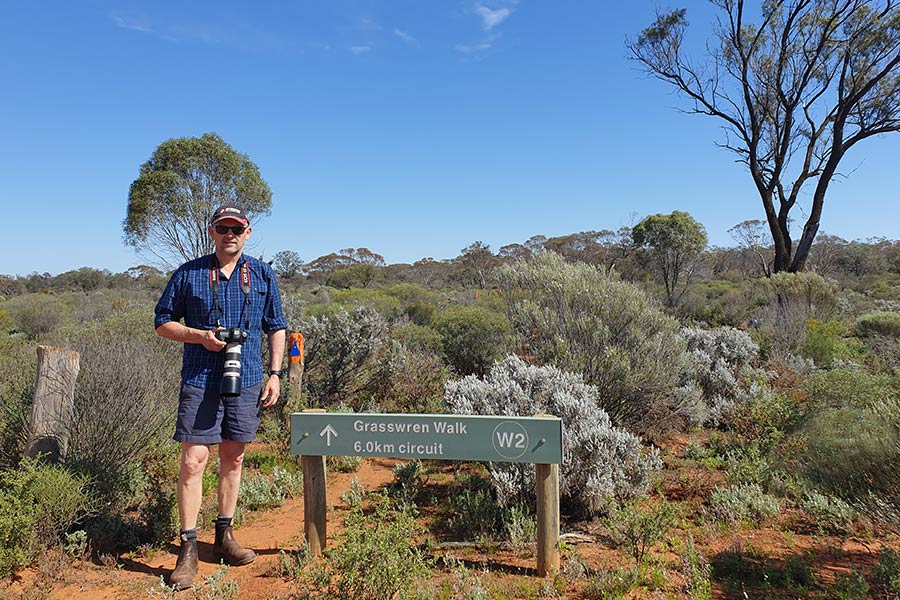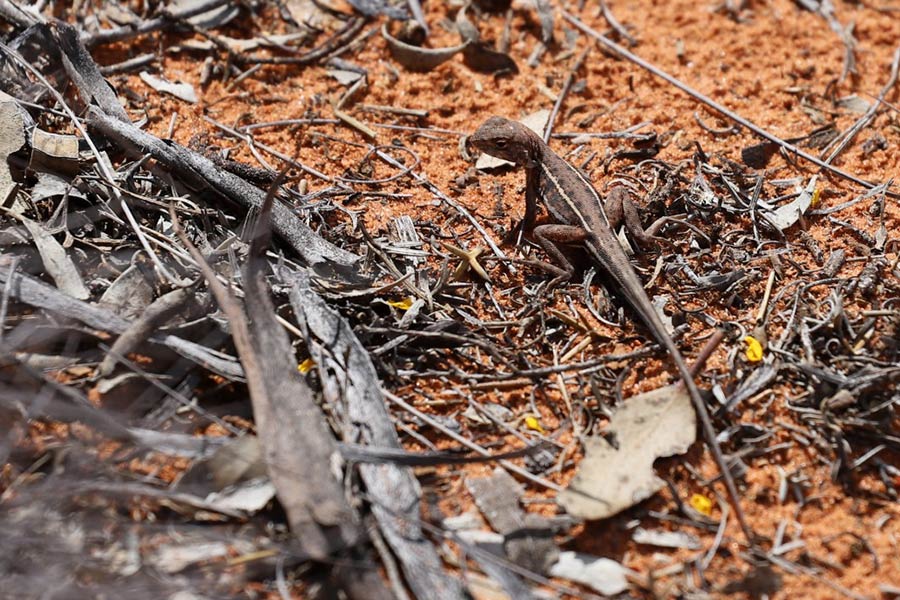A conservation, camping, hiking, and wildlife-watching delight!
A little birdy told me about a fabulous conservation reserve you’ve probably never heard of. So, tell me honestly – have you ever heard of Gluepot Reserve?
Nah, me neither, until recently.
This place is a hidden gem to explore. For extra feel-good points, you’re supporting their team of volunteers kicking conservation goals. Gluepot is 3.5 hours northeast of Adelaide, owned and run by Birdlife Australia. As a crow eater (umm, does that sound wrong for bird conservation?), I’ll admit this SA gem had slipped under my radar… and at 54,000ha, that’s a big blind spot.
But ‘secret spot’ no more! I recently explored this magical place, and now think its name should be ‘Super’ Gluepot Reserve. Now, I can tell the difference between a black cockatoo and a raven. That said, I’m the first to admit I don’t know the intricacies of a white-fronted versus a white-plumed honeyeater – and that’s OK. Yes, Gluepot is a birder’s paradise – but it’s also mighty fine for hikers, mountain bikers, campers, off-road tourers, and nature lovers.

‘Super’ Gluepot Reserve is ready to explore! Credit: Mariska and Mark Threadgold
Birdlife Australia
Did you know that Gluepot Reserve is Australia’s largest community-run conservation reserve? Hats off to these legends, because volunteers run the entire operation. Their goal is to protect and enhance our fragile environment. Thankfully too, they want to share this fabulous piece of mallee scrub with tourists.
Gluepot was marginal farming land at risk of being burned to make room for stock fodder. Fortunately, volunteers were aware of the site’s environmental significance and conducted extensive surveys. The property owner was willing to sell the Gluepot section, but Birdlife Australia needed to raise $360,000 for the purchase – plus ongoing funds for upkeep and maintenance. In 1997, they raised the money in just 10 weeks. Over 2,400 individuals and organisations donated the funds. Talk about people-power!
The primary focus is on conservation, research and education. At various times there will be a selection of students, researchers and specialised equipment on site.

Throughout the reserve, you will find signs of crucial environmental research and monitoring. Credit: Mariska and Mark Threadgold
Activities
Bird, Flora, and Fauna Watching
Grab the binoculars and watch nature to your heart’s content. With Gluepot’s conservation emphasis, look for the many bird-hide watering stations and other monitoring sites.

Check out the numerous bird hides. Credit: Mariska and Mark Threadgold

Hiding out in a bird hide. The best vantage point for some feathered action – and cool on a hot day. Credit: Mariska and Mark Threadgold
Off-Road Touring
There are many well-signposted dirt tracks around the property. Planning a round trip to check out the features and activities is easy.

On the road out to Gluepot Reserve. The road is generally suitable for 2WD vehicles and medium-sized caravans – perhaps don’t bring your sports car. Credit: Mariska and Mark Threadgold
Walks and Mountain Biking
There are 14 established trails for walking and mountain biking, from one kilometre long to 15! Excellent and informative paper guides are available from the visitor centre.
You can explore other park areas if you’re an experienced and well-prepared hiker. Due to the thick mallee scrub, it’s easy to get lost without trails or a compass/GPS. The northern end of the reserve has restricted access for research purposes.

Don’t forget the camera. Whether it’s wildlife or natural spaces, there’s plenty to photograph. Credit: Mariska and Mark Threadgold
Research Courses, Art, and Camps
At various times throughout the year, there are special programmes and courses. Offerings include research activities, art classes, and even a campout for the youngsters.
Volunteering
They’d love more “Friends of Gluepot Reserve”, if you’re keen. Volunteers help as rangers, flora/fauna monitors, and feral animal and weed controllers. Construction and maintenance tasks performed by volunteers are greatly appreciated. Of course, a few dollars donated will help this fantastic project too.
Camping
Oooh – not one, not two, but three great campsites to choose from!
Babbler Campsite is the closest to the visitor centre and has 18 sites. Sitella hosts 17 camp spots located northwest of the central visitor centre.
We chose the furthest, Bellbird, to avoid the potential, long-weekend crush. There was no need to worry, because the 15 campsites were only half full.
We were super impressed with the campground. Clean, well set up, and most sites had space and greenery between them. Two drop toilets and a few tables/seats were available too.

Fabulous camping amongst the Mallee scrub. Credit: Mariska and Mark Threadgold
Wildlife
OK, let’s start with the main stars.
Gluepot is home to over 190 different species of birds. That’s enough to get any birder into an excited flap. Gluepot helps protect 18 nationally threatened birds. The dense mallee shelters the threatened mallee fowls, red-lored whistlers, scarlet-chested parrots and black-eyed miners.

This cheeky Mulga parrot was happy checking out our campsite. Credit: Mariska and Mark Threadgold
Gluepot’s furry (and spiky) residents include grey and red kangaroos, echidnas, and pygmy possums. Twelve different bats and 53 species of reptiles call Gluepot home.
Now, whilst we enjoyed seeing many of the small and large lizards, we did give a wide berth to a slithery snake during a walk.

Hide and Seek – lizard style (Eastern Mallee Dragon). Credit: Mariska and Mark Threadgold

Plenty of sand goannas call Gluepot Reserve home. Credit: Mariska and Mark Threadgold
Gluepot rounds off its environmental preservation with over 260 species of plants.

It’s hard not to stop at this bright beauty. Credit: Mariska and Mark Threadgold
The Visitor Centre
Start at the visitor centre! It has fabulous displays and is the central hub for all the information, guides, and maps you’ll need. Here, it’s a self-service and honesty-based system. Grab a park map and fill out the camping/visit pass.
Make sure to check out the displays covering the reserve’s history, management, and unique inhabitants. Pick up a walk or drive brochure. The brochures provide directions and extra information about history, fauna, flora, or park management.
There are extensive lists and literature if you’re a birder or a leafer (OK, I just made that name up). Here, you can knock your feather and flora socks off. Oh, and check out the cute and colourful artwork out front. There’s clothing and other merchandise available too.

The visitor centre contains interesting displays and park information. Credit: Mariska and Mark Threadgold
Top Tips
Contact Gluepot
Do so a few days before, to check if they expect large group bookings at any particular campsite. You can also check the track status. The name ‘Gluepot’ originates from the clay soil’s knack of sticking during rain (now that would be a funny phone call to work – ‘I’m not coming in today because I’m stuck in a gluepot’).
Be sure to do the Old Gluepot Heritage Walk
It’s great to discover the history of the original station. You can even walk into the underground room and experience the temperature drop, first-hand.

Experience the temperature drop as you descend into the old underground room on the Old Gluepot Heritage Walk. Credit: Mariska and Mark Threadgold
Be prepared for insects!
The flies were friendly, but the mozzies were nasty. Nothing a fly net, repellant, and coils couldn’t fix though.
It’s Mallee country, so it can be hot and sunny
Slap on a hat, slop on that sunscreen, and stay hydrated.

Water is essential in this dry landscape. The water points are popular with all sorts of birds, including brown-headed honeyeaters. Credit: Mariska and Mark Threadgold
Where, When, and How Much?
Gluepot is 3.5 hours north-east of Adelaide. It’s 64 kilometres from Waikerie in the Riverland. The final 50 kilometres are dirt roads generally suitable for 2WD vehicles and mid-size caravans. The tracks and park may close when rainfall exceeds 15mm.
The ideal times to visit are from Autumn through to Spring.
Day Visitor: $5.00 per vehicle
Camping: $15.00 per vehicle
Contacts:
Ph: (08) 8892 8600

Get ready for red sands, grey-green foliage and blue skies. Credit: Mariska and Mark Threadgold
So now you know the secret…
Gluepot Reserve is super!
We were delightfully surprised and impressed by our trip to Gluepot Reserve. Yes, we were also a tad embarrassed that we never knew this Mallee gem existed in our own backyard.
Do yourself a favour and add Gluepot to your bucket list. Tell them a lil’ birdy sent you.
Tell us, what’s your favourite surprising or secret travel experience? Let us know in the comments!

4WD & Camping Addict | Word Nerd | Bucket List Ticker | Camp Gadget Gidget | Sweet Tooth | RndOz Lapper!
When not off-road travelling, you’ll find Mariska driving a keyboard – although, you should check the nearest bakery or cellar door! Mariska is a freelance SEO copywriter, content marketer, and travel journalist obsessed with all things 4WDing, camping, and exploring Oz. Her cheeky, enticing, and playful writing connects travel, 4WD, and outdoor fans with epic brands, destinations, and products. She’s on a mission to inspire people to get outdoors, explore this great country, and cross things off their bucket lists (and find the best coffee and cake combo in Australia)!
Follow her on Instagram, Facebook, LinkedIn, or her website.
Such a fabulous place to visit. And, you’re supporting an awesome cause.
Do yourself a favour, pack the camping gear, grab your hiking boots and explore Gluepot Reserve.
Enjoy.